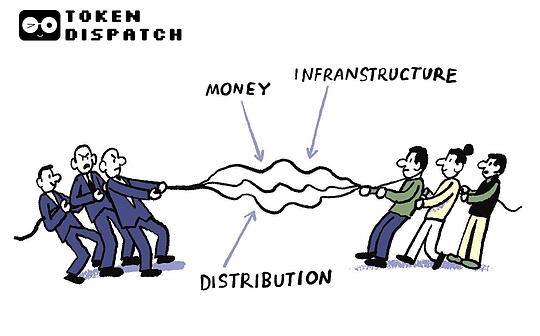
Author: Zhixiong Pan Source: chainfeeds
Although the Ethereum Foundation officially announced the privacy wallet tool Kohaku project yesterday, it had actually confirmed the project through some channels as early as June this year.
Kohaku will collaborate across multiple teams, integrate multiple components, and implement a complete set of browser plug-in wallets that can be used as a reference for other wallets to improve end-to-end privacy.These include the Helios light client developed by a16z, the Ethereum Foundation’s PSE team, as well as Ambire, Railgun, Wonderland, and more.
The origin of the word Kohaku is also quite interesting. Because the project was forked from Ambire, the Japanese word for Amber was chosen: Kohaku.But in Japanese, it also means “koi” (especially red and white), so this project also uses koi as an image.

What is Kohaku?
Kohaku is a set of privacy and security primitives and SDK for “wallets”, coupled with a reference wallet (browser extension) for advanced users to actually run these capabilities.
Kohaku is not intended to be a public C-side wallet, but to provide composable privacy/security building blocks for various wallet teams. You can access “all” or “part” (plug-in) as needed.The initial focus is on privacy features, with the reference wallet being a browser extension forked from Ambire.The official clearly emphasizes that the main network should be given priority and then gradually support L2 (and focus on the “fast withdrawal” capability).
Kohaku’s core goals are:
-
An SDK for strong privacy/security primitives;
-
A reference wallet based on the SDK for heavy users;
-
Cooperate with other wallets to access all or part of the capabilities as needed;
-
The reference wallet is a fork of Ambire, with mainnet first and L2 added later;
-
Both the SDK and the reference wallet come with a plug-in system, allowing each wallet team to select functions as needed.
Core direction: not only “privacy on the chain”, but also “end-to-end”
Kohaku’s privacy is not as simple as “putting transfers into a private pool”, but considers trust and exposure at every step from the device to the node.The roadmap lists a very clear “privacy/security item list”:
-
Built-in Helios light client (WASM): pull the blockchain status verification to the local machine and try not to rely on centralized RPC.(Helios is a multi-chain Ethereum light client produced by a16z. It can be compiled into WASM and is suitable for embedding in wallets and dApps.) 
-
Minimal execution client + private eth_call: Even if you just read the on-chain status (common eth_call), “let the server not know what you are reading.”The roadmap states that “TEE+ORAM (Trusted Execution Environment + Implicit Access) will be implemented first, and the long-term goal is pure cryptography PIR.”
-
Private sending/private receiving/private payment request: The wallet has multiple built-in privacy protocols (including Railgun in the first batch), supporting “private sending/receiving” and “encrypted payment request”.
-
Unified view of private balances (multi-protocol aggregation): If you have funds in multiple privacy protocols, the wallet will give an aggregate view.
-
Avoid IP leaks and hidden traffic, optional P2P broadcast transactions (bypass traditional RPC broadcasts).
-
When connecting to a dApp, the default is “one dApp, one account”: naturally reducing address correlation.
-
Social retrieval (ZKEmail / ZKPassport, etc.): Use zero-knowledge to “retrieve” without revealing your identity.
-
Post-quantum “emergency switch”: When necessary, you can switch to post-quantum signatures such as Falcon/Dilithium (Solidity verifier optimization) to prevent quantum security risks.
-
Universal Hardware Ethereum App/ZK Hardware Signer/Consumption Limit Strategy: Make hardware-side capabilities an open source reference implementation, break vendor lock-in, and introduce a more detailed “expenditure strategy.”
You can understand it as: “On-chain privacy pools” such as Railgun are one of the bases, but Kohaku also needs to fill in the “holes that are easy to leak privacy” such as node trust, network broadcast, front-end connection, recovery, and hardware signatures, so as to achieve “less exposure from end to end.”
Roadmap and cooperation ecology
-
Phase 1: Privacy/security basic capabilities.
-
Continuing direction: Keep the wallet as “close to the device/kernel” as possible, and even explore “native Ethereum browsers” in the future, with IPFS front-end, deeper P2P integration, local AI transaction security scoring (no data leakage), etc.
-
Collaborative teams: Ambire, Railgun, Wonderland, Helios, PSE, Oblivious Labs, ZKnox, and more.
Product form: SDK + reference wallet (browser extension)
-
SDK: “Privacy/security” composable module for other wallet teams.
-
Reference Wallet (Kohaku Extension): A browser extension based on the Ambire branch. It is used to “run these privacy and security capabilities, demonstrate and proof”. It is positioned as an advanced user and is not a final product for the general public.
-
What you can currently see on the GitHub side is that the main repository (ethereum/kohaku) is a monorepo, and the @kohaku-eth/railgun package (“railgun privacy protocol lib”) is listed.There are also kohaku-extension and kohaku-commons repositories. The former is the extension code (based on Ambire), and the latter is Ambire’s public logic library (introduced by the branch).
-
The home page of the warehouse also prompts: It is still under development and the production environment is not ready yet.
Why is it more “private” than MetaMask?
Let’s first talk about the current status of MetaMask or other wallets:
-
You use an open account (EOA), and your address and transactions are permanently public.
-
When you interact with dApps, you often use centralized RPC (such as Infura), and the RPC service can see the requests and IPs you initiate.
-
If you often use the same address to connect to different dApps, it is easy for the chain to analyze the associated profile.
How does Kohaku rewrite this path?Kohaku uses a set of “end-to-end” methods to block “correlated information” as much as possible. The core difference lies in these three layers:
-
On-chain transfer itself
-
Through protocols such as Railgun, the “money you want to transfer” is first shielded (into the pool) to a private address (0zk), and then “transfer/interaction” occurs in the private pool; what is seen on the chain is new commitment/Nullifier (anti-double spending) and other encrypted accounting, which will not directly expose the source, destination, and amount of the funds.Railgun documentation is clear: 0zk addresses never appear on the chain, and the system updates status and prevents double spending based on UTXO/Note + zk proof.
-
Note: Shield and Unshield (out of the pool) themselves are visible on the chain (because you need to deposit/withdraw ERC-20 into the contract), but the “conversion, transfer, and call” in the pool are private.Railgun currently charges a 0.25% rate for Shield actions (determined by its DAO; only Shield charges, not private transfers within the pool).
-
Interact with nodes/networks
-
The Helios light client is embedded in the wallet: many read verifications are done locally, reducing trust and exposure to RPC (especially reading).
-
The planned “private eth_call”: Even if you just read the on-chain storage, you must use TEE+ORAM (the long-term goal is PIR) so that the peer cannot see what you specifically read.
-
Optional P2P broadcast: Transactions are not sent directly through traditional RPC, reducing the binding probability of “your IP + your transaction”.
-
Frontend/Connectivity & Relevance
-
Default “one dApp, one account”: Every time you connect to a dApp, the wallet will suggest you use a “new address/new account” to avoid cross-site profiling.
-
Private payment request/private reception: The “0zk payment information” passed to the other party using the link/QR code for payment does not appear on the chain.
-
Social retrieval also uses ZK: such as ZKEmail, ZKPassport, and Anon Aadhaar, so that “recovery” does not leak privacy.
Complete user experience from MetaMask to Kohaku
You can understand it as: first “put the money in a private wallet”, do things in it, and then decide how to “get out”.
-
Step A: Install the Kohaku browser extension and import your mnemonic phrase or create a new one.
-
Step B: Turn on “Private Mode” in the settings and check the Railgun plug-in (Kohaku supports multi-protocol plug-ins).The wallet generates key material locally for 0zk.
-
Step C: Shield (into the pool): Store the ERC-20 you want to use “privately” into the Railgun contract (if it is native ETH, it will be wrapped into wETH first and then added to the pool. This is Railgun’s rule).This step is visible on the chain (because it is paying money to the contract), but this is the only “public transaction” that “enters the private space”.
-
Step D: Transfer/Swap/LP/Interact with dApp contract in the private pool, etc.The ZK proof will be generated locally. Only the commitment/Nullifier updates will be seen on the chain, and you will not be able to see how much you transferred to whom.
-
Step E: Private payment: You can send the 0zk payment link/QR code to others, and this address information will not appear on the chain.
-
Step F: If necessary, unshield (out of the pool) to a new public address (it is best not to return to the original address to reduce the association).Some protocols or front-ends may be configured with delay windows/compliance checks (such as the Privacy Pools direction and the certification mechanism of the Railgun community); the Railgun ecosystem has also introduced mechanisms such as “a short observation period where only the original path can be returned” to take into account compliance.
-
Step G: You can optionally enable P2P broadcasting, independent accounts for each dApp, and Helios local verification to further reduce “metadata that can be bound”.
Which part is still visible?
-
Your deposit (Shield) to the privacy pool and your withdrawal (Unshield) from the privacy pool are both public transactions.However, transfers/interactions within the pool are private (the sender, receiver, and amount cannot be seen, only the “pool status” is updated).
-
If you “withdraw money” directly back to “the public address where you made the deposit before”, analysts may still “reasonably guess” that the two are related – it is best to withdraw to a new address, or continue to spend money in the private domain.
Summarize
Kohaku introduces a new privacy and security paradigm to the Ethereum wallet ecosystem, going beyond simple on-chain privacy protocols and moving towards deep integration of end-to-end privacy protection.It will significantly improve users’ privacy experience when interacting with decentralized applications, change the current generally transparent on-chain behavior model, and set a new standard of “privacy by default” for future wallet products.
As its SDK and plug-in system are widely adopted by more wallet teams, the way users interact with the blockchain may be reshaped: from transparency to privacy, from centralized trust to local verification, and from public identity on the chain to zero-knowledge identity.Kohaku will promote the Ethereum ecosystem to enter the mainstream era of privacy applications, accelerate the exploration of innovative models that coexist with compliance and privacy protection, and lay a key foundation for the next stage of decentralized Internet.







